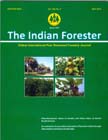Kanamycin Sensitivity in Cultured Leaf and Petiole Tissues of Himalayan Poplar (Populus Ciliata Wall.)
DOI:
https://doi.org/10.36808/if/2012/v138i4/4634Keywords:
Populus ciliata, Kanamycin Sensitivity, Regeneration, TransformationAbstract
Kanamycin sensitivity studies were conducted in leaf and petiole tissues of Himalayan poplar to investigate the suitability of kanamycin resistance as a selectable marker for genetic transformation. Increasing concentrations of kanamycin i.e. 10, 20, 30, 40 and 50 mg/l was given to find out the minimum dose of kanamycin required for the selection of putative transformed cells during genetic transformation. A decrease in fresh weight in leaf and petiole explants was observed with the increase in kanamycin concentration. At 50 mg/l kanamycin, callus formation and shoot regeneration was blocked and the explants turned brown and started dieing. The higher tolerance level of leaf and petiole tissues of Himalayan poplar up to 50 mg/l kanamycin concentration indicated that this concentration of kanamycin would be the most useful for selection of npt-II gene transformed leaf and petiole tissues of Populus ciliata.Downloads
Download data is not yet available.
Downloads
Published
2012-04-01
How to Cite
Thakur, A. K., & Srivastava, D. K. (2012). Kanamycin Sensitivity in Cultured Leaf and Petiole Tissues of Himalayan Poplar (<I>Populus Ciliata</I> Wall.). Indian Forester, 138(4), 339–343. https://doi.org/10.36808/if/2012/v138i4/4634
Issue
Section
Articles
License
Unless otherwise stated, copyright or similar rights in all materials presented on the site, including graphical images, are owned by Indian Forester.





